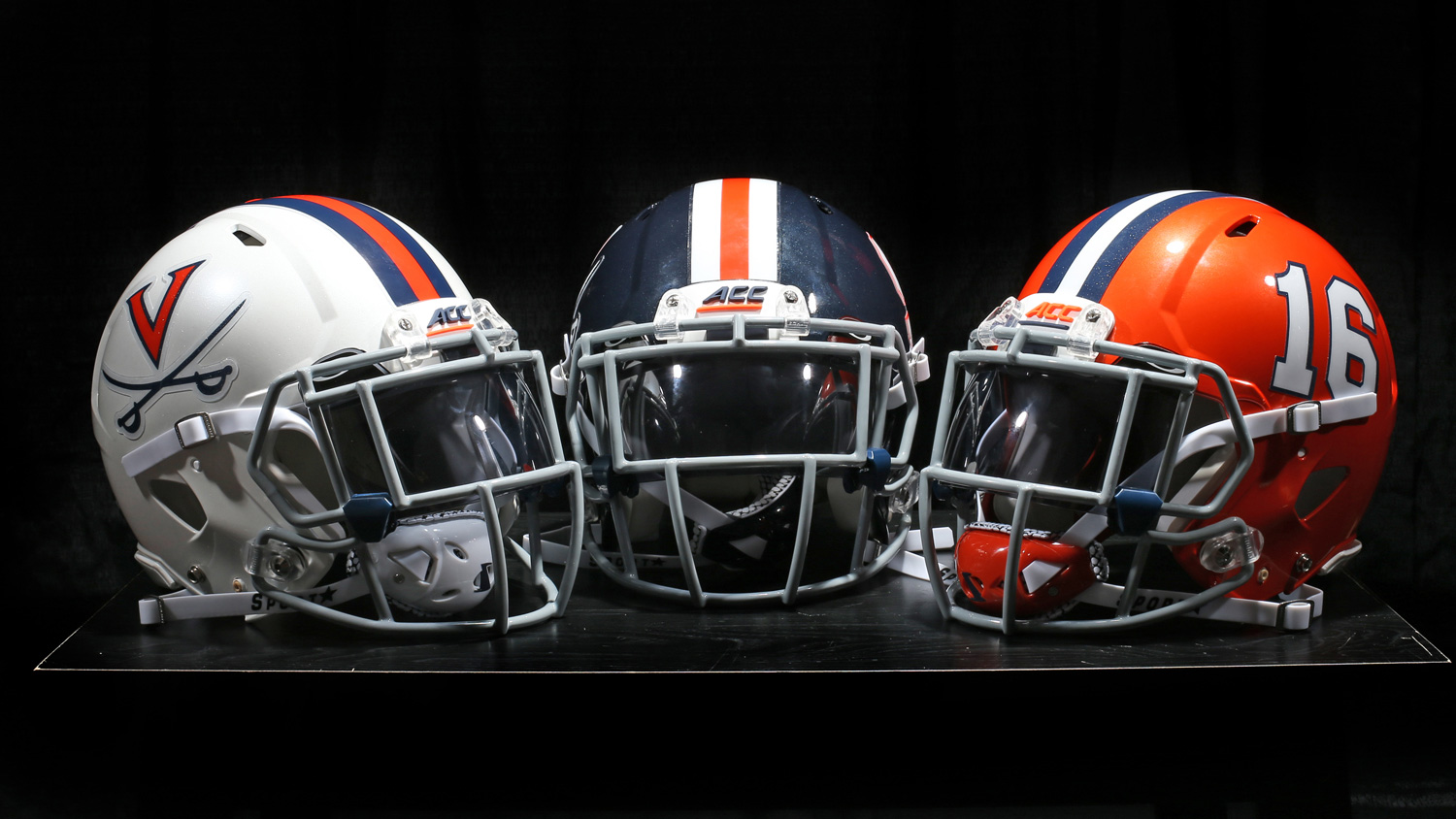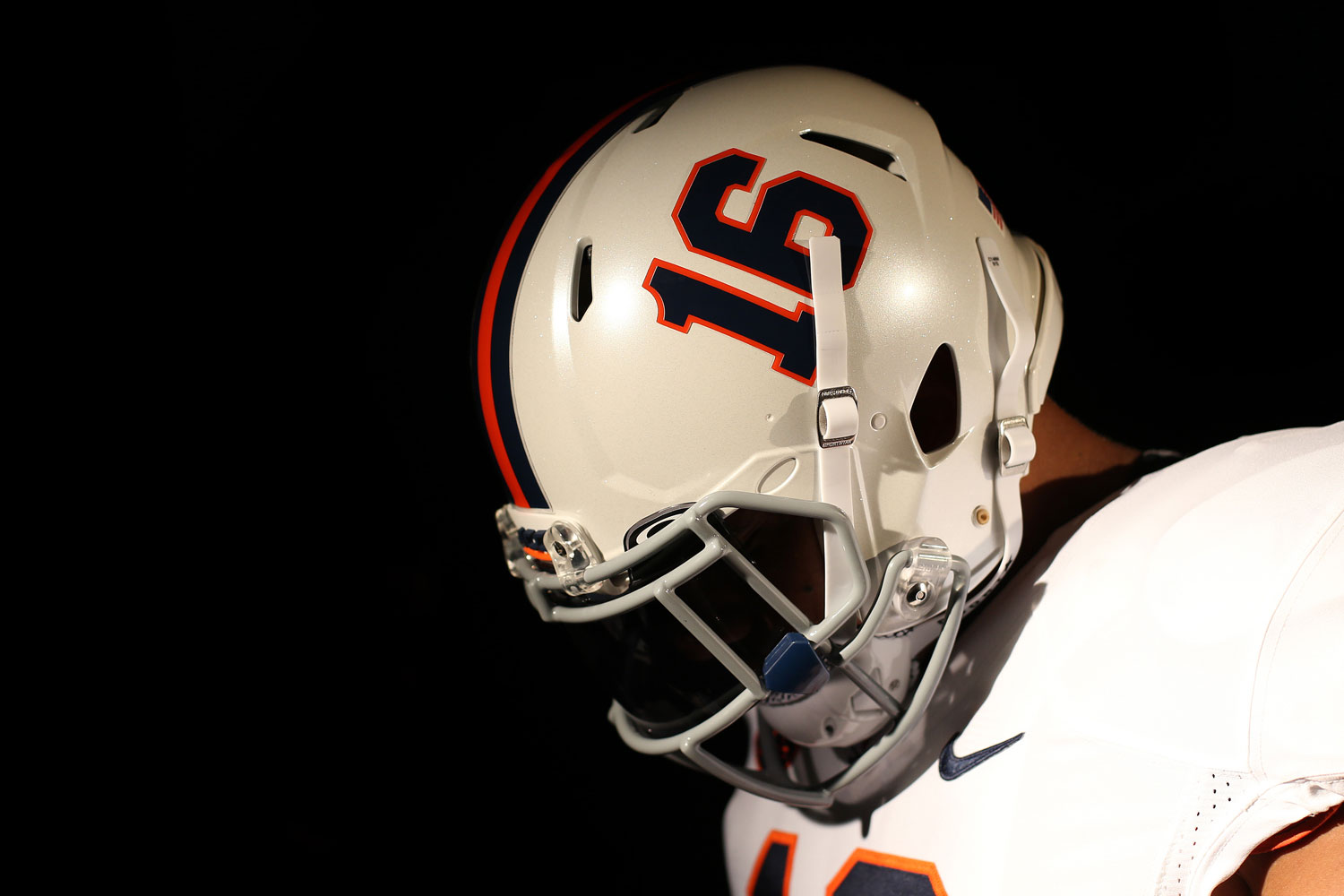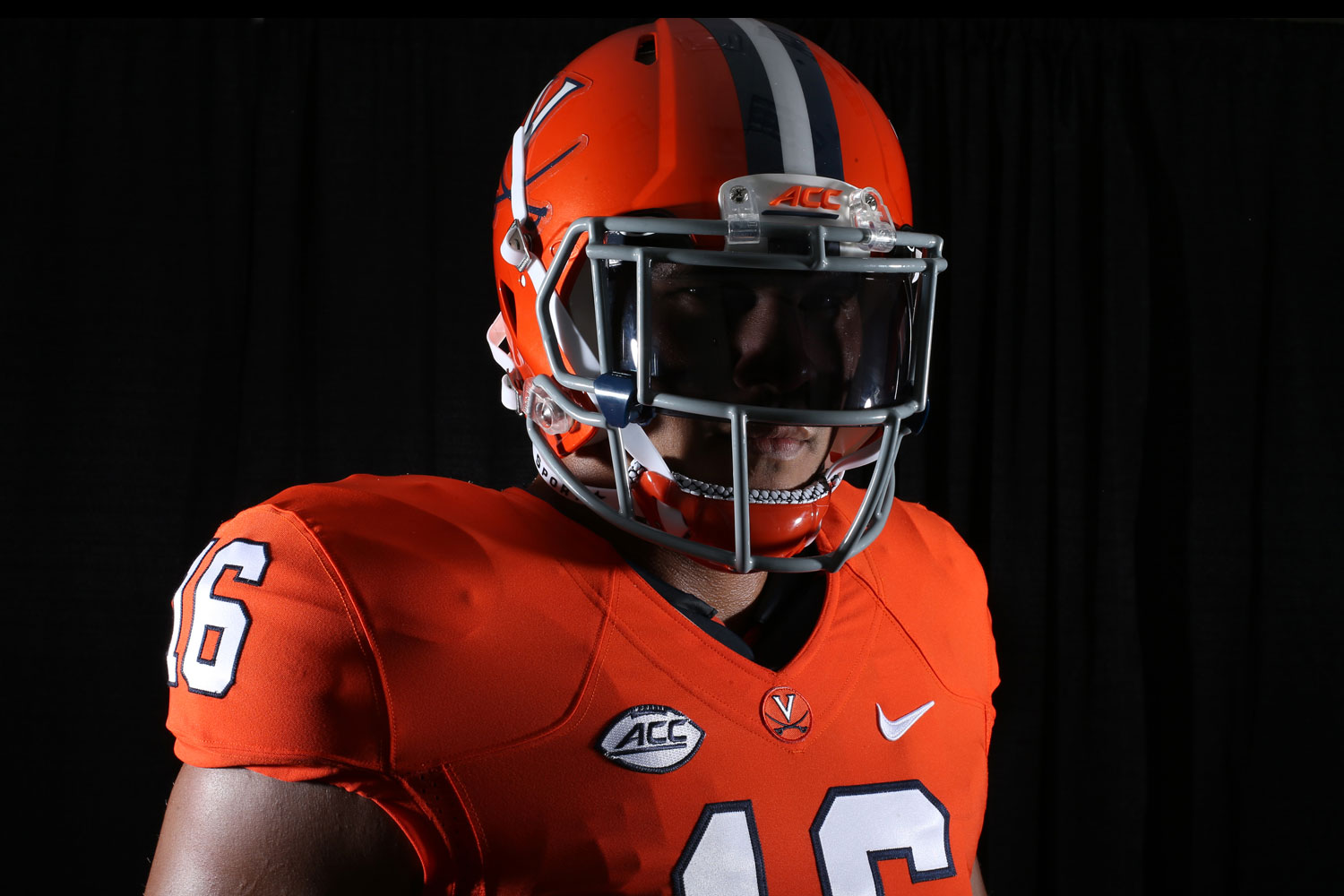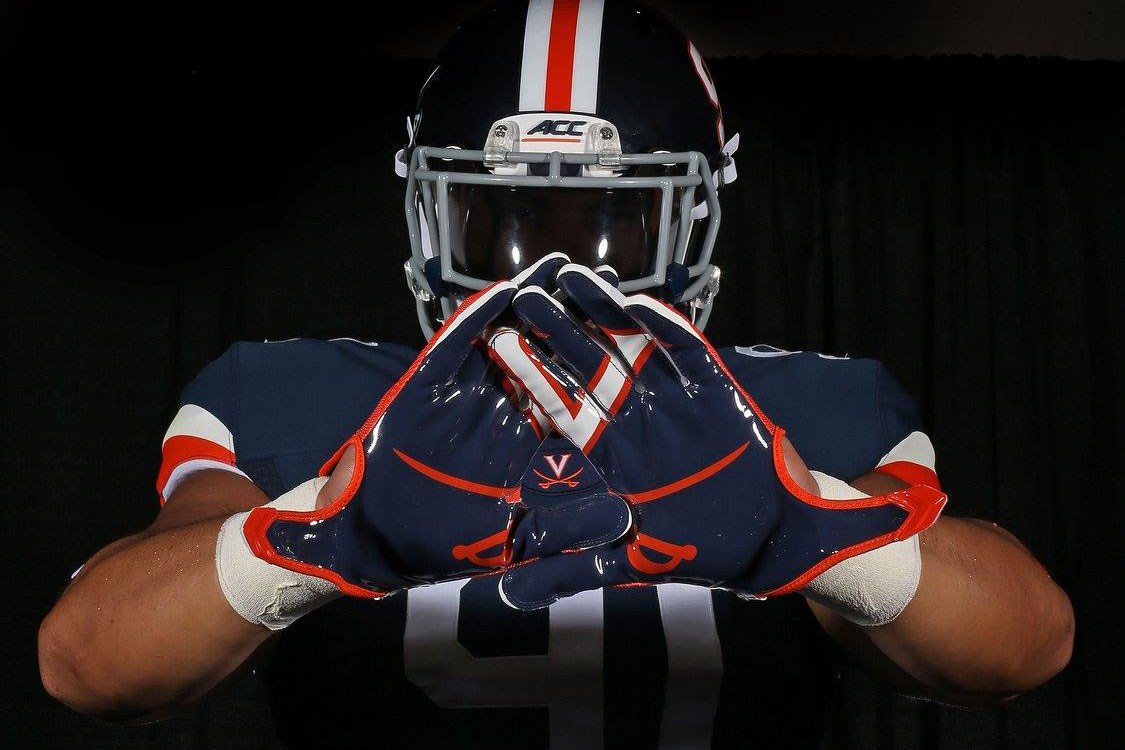In the hallway outside Bronco Mendenhall’s office in the McCue Center hangs an enormous photo taken Oct. 15, 2005. It’s an aerial shot of a packed Scott Stadium on the night when the University of Virginia football team, led by quarterback Marques Hagans, knocked off No. 4 Florida State, 26-21.
When the Cavaliers play their first game under Mendenhall, their new head coach (whose assistants include Hagans), the end zones will be painted as they were for that epic upset, with each letter of “Virginia” inscribed inside linked diamond shapes.
“I think it’s a classic,” Mendenhall said of the diamond design, and that’s not the only thing in the photo that caught his eye.
“I couldn’t find an empty seat as I looked at the stadium,” Mendenhall said, “and I couldn’t see any grass [on the hill at the north end], because it was jammed full of people. And I saw people standing on the concourses. I thought, ‘This is UVA football.’ And it will take all of us – our team, our coaches and the community – to return it to that.”
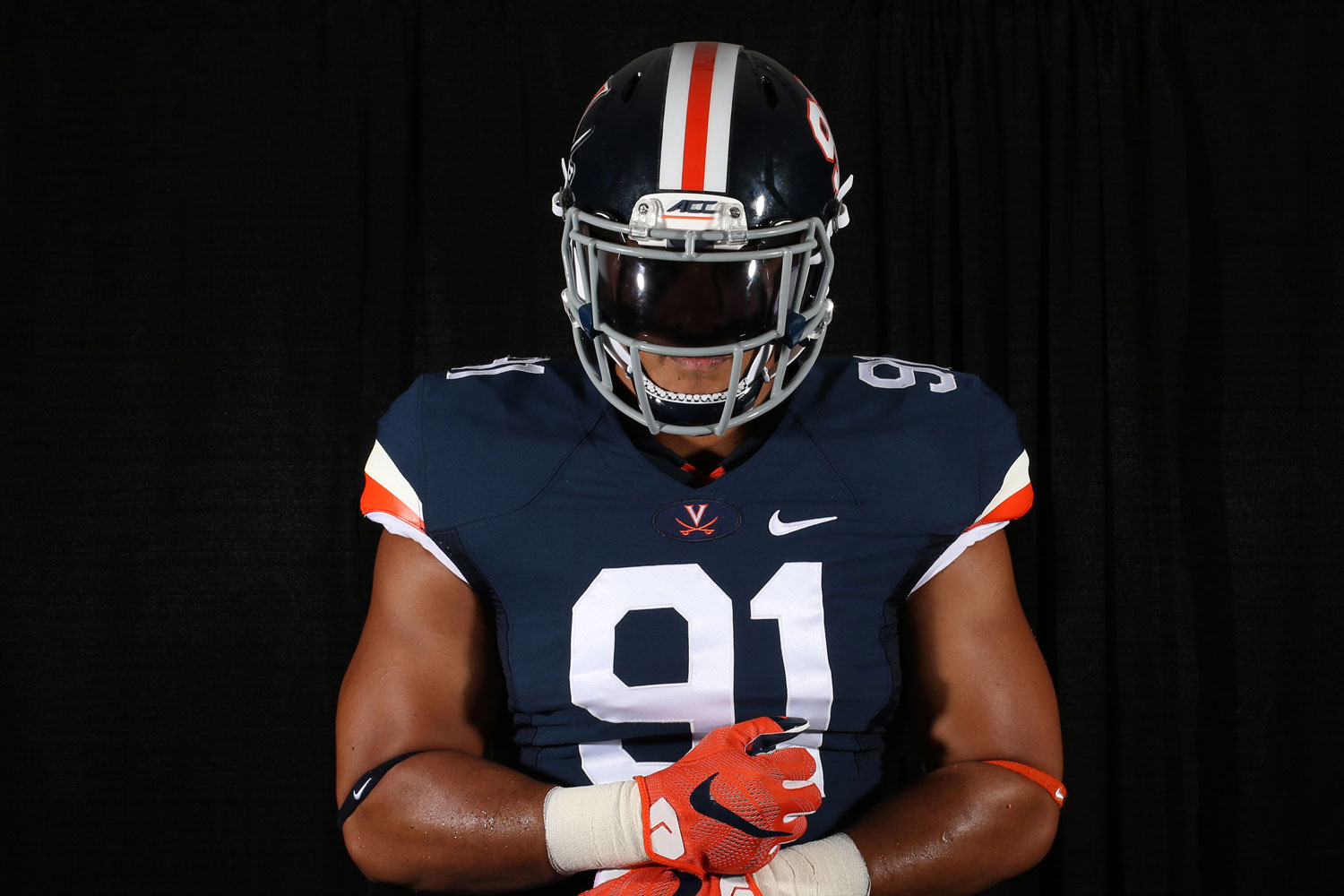
University of Virginia football players will also wear new uniforms this season. (Image courtesy Virginia Athletics)
Virginia opens the Mendenhall era at 3:30 p.m. Saturday against visiting Richmond, and fans will note multiple modifications to the game-day experience at Scott Stadium.
The Wahoo Walk, which was held two hours before kickoff in the west parking lot, will no longer take place. Fans will be offered a free game program upon entering the stadium, and they’ll notice new designs for the Cavaliers’ uniforms and helmets. The team will take the field after a new pregame video that replaces the “Adventures of Cavman,” but the players will still follow the Cavalier on horseback. Also, several new offerings will be available at the concession stands.
“I want it to be inspiring,” Mendenhall said. “I want folks to come and bring their kids and bring their parents and bring family members to have an amazing time and leave inspired by young people that are trying as hard as they can try, together, for a cause.”
For much of the 1980s and ’90s and part of the 2000s, Virginia football enjoyed significant success. But only twice in the past decade have the ’Hoos finished with a winning record – in 2007 and 2011 – and Mendenhall was hired to reverse that trend.
Since coming to Charlottesville in December after 11 seasons as Brigham Young University’s head coach, Mendenhall has spent untold hours researching his new football program and the University itself.
“It’s been a work in progress and an amazing experience to learn about UVA, to learn about my team, to learn some of the history of this institution, and then consider and think about the best ways to honor all of that,” Mendenhall said.
“What we wear I hope connects eras, but also the community to the eras where we can acknowledge the past, but also look forward to a really, really bright future.”
When Mendenhall has made changes, he’s done so to better “represent the direction and the philosophical approach that we’re taking to the program,” he said.
“It doesn’t mean that there’s not value to what’s been done before. I’m trying to take all of that and add to it to make it a better version, or a more representative version, of the direction we’re going.”
The team will have three uniform options this season. At home, Virginia’s primary combination will be blue jerseys and white pants with blue helmets, Mendenhall said, but for special occasions the team may break out orange jerseys with orange helmets.
Given the color’s prominence at UVA, Mendenhall said, “it seemed necessary and it seemed right to have the orange option.”
For road games, the ’Hoos will wear white jerseys and white pants.
Each helmet – blue or orange at home, white on the road – features three center stripes, with the player’s number on the left side and the V-Sabre on the right. Facemasks are gray, which to Mendenhall symbolizes the “blue-collar, no-frills mentality” he wants his team to have.
“There is grit, there is determination, there is resolve,” he said.
The players have completed spring practice and, now, training camp without numbers on their jerseys. Along the way, the six leaders of the team’s “task units” have been evaluating the work ethics of the players under their direction.
“They’ve gone through all the summer workouts, which were graded,” Mendenhall said. “They’ve gone through the spring, which was graded. And they’re literally selecting – the task-unit leaders are selecting, based on merit – our team’s selection order, one through how many there are, on what those players have earned.”
The players will select their numbers in an order determined by the task-unit leaders. There’s likely to be symbolic meaning to the jersey numbers chosen.
“Someone might say, ‘How come No. 8?’” Mendenhall said, “and they’ll have a chance to tell their story. Or, ‘How come No. 15?’ Or, ‘How come No. 53?’
“And I bet when someone asks that question, there’s a story. And if that leads to that, it now gives the player a better chance to play for that purpose, which will bring the best out of them.”
In new uniforms with freshly chosen numbers, the players will burst out of the locker room and charge onto the field a few minutes before kickoff Saturday.
“We have a very simple ritual to take the field that represents that we’re not going to be very effective by ourselves,” Mendenhall said. “It will take everyone. So we hold hands. That actually allows us to move as one, meaning if someone’s slightly ahead of another, they’re pulling them along or helping them. I like that idea, as a community and a state, that we don’t leave anyone behind and we work together.”
After a walk-up that consists of three synchronized steps – representing U-V-A – the task-unit leaders will snap their hands down in unison, yell “’Hoos!” and then take the field at a sprint, their teammates following them.
The Cavalier, mounted on his horse Sabre, will ride out of the tunnel at a pace that reflects “how we intend to approach the game,” Mendenhall said.
“He’s not coming out at a trot, and he’s not coming out at a walk. There is an intentional direction and speed, with a drawn sabre [to show] we mean business, and we’re lucky to actually get a chance to do something about it.”
Media Contact
Article Information
August 29, 2016
/content/symbolic-changes-mark-new-era-scott-stadium

